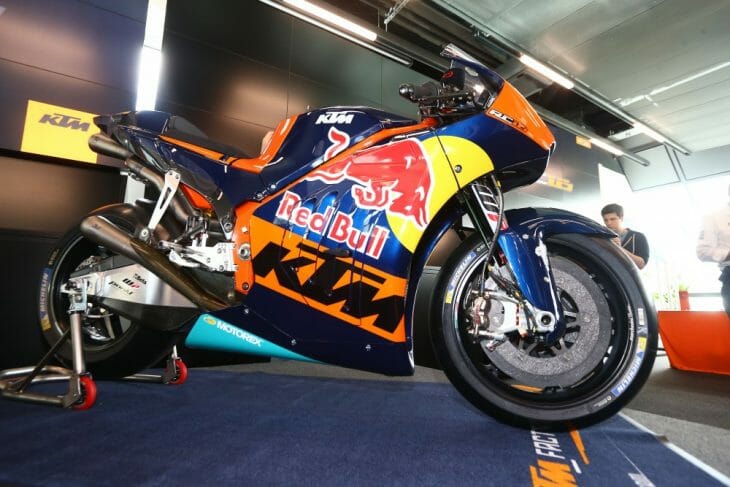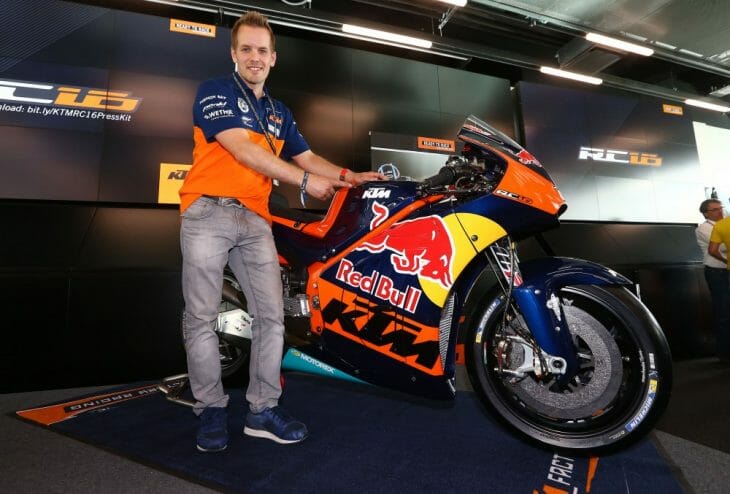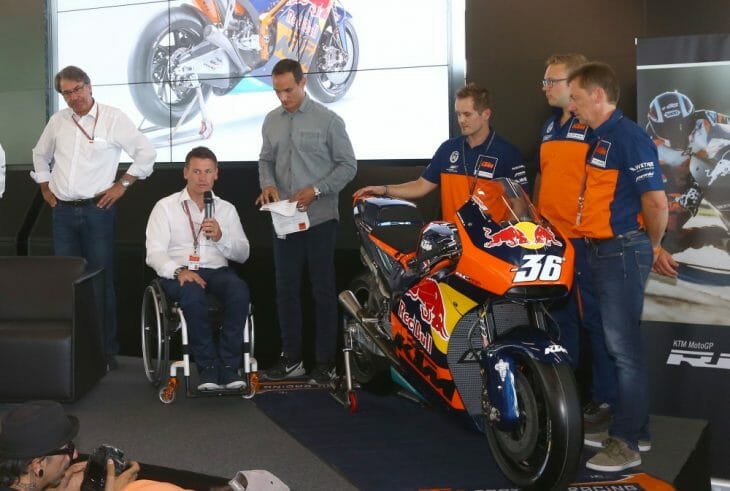Michael Scott | August 13, 2016
 KTM won’t be making the same mistakes in 2017 as their disastrous 2005 collaboration with Team Roberts.
KTM won’t be making the same mistakes in 2017 as their disastrous 2005 collaboration with Team Roberts.
KTM’s return to the MotoGP class was launched in a good-natured ceremony in the press room, with the current version of the RC16 V4 on display, and test rider Mika Kallio joining KTM boss Stefan Pierer and racing chief Pit Beirer on the stage.
The Austrian company had in ill-fated and under-budgeted attempt in 2005, supplying engines to an equally cash-strapped Team Roberts, but did not complete the season. This second attempt has little in common, after extensive development and testing, backed by a company that has in the interim grown from 800 to 2,800 employees, has all but taken control of Moto3, and is now the biggest bike manufacturer in Europe and still growing.
The decision to rejoin the big class dates back to 2014, after the company had been turned down as engine supplier for Moto2. According to Dorna CEO Carmelo Ezpeleta, “it was not difficult to convince them to join MotoGP instead”.
 Kallio’s been involved with the on-track development from the beginning and has shown the bike’s early potential.
Kallio’s been involved with the on-track development from the beginning and has shown the bike’s early potential.
Typically, the bike is a little different from the norm. While the V4 engine is par for the course, the use of White Power rather than Öhlins suspension is unique in the class, and likewise the steel tubular chassis. It is similar to the tube chassis in their Moto3 bike.
According to technical director Sebastian Risse, this was more a matter of familiarity with the material than a desire to buck convention. “You have to know the advantages and disadvantages, and then use them,” he said.
According to the company’s motorsport chief Pit Beirer, the infrastructure was already in place to run two riders. “We are ready to race now. We have two crews, and strong engines that didn’t break. We have tested on all kinds of tracks, with big and small riders. And we are not dramatically far away.”
At Red Bull Ring tests before the summer break, the first time KTM had met their potential rivals, test rider Kallio was less than two seconds off the flying factory Dukes, and half-a-second off the private Hondas. Also faster than (the admittedly injured) Loris Baz.
 The KTM boys are undoubtedly proud of their new baby, we’ll see how it fares at the season ending Valencia Grand Prix.
The KTM boys are undoubtedly proud of their new baby, we’ll see how it fares at the season ending Valencia Grand Prix.
Kallio said that from the start, “the bike had a good basis. There were a lot of things to improve, but step by step we are in a good way and at a good level.”
The bike is still very much a work in progress, however, with some design elements apparently not settled.
The factory men were coy about several details. Asked whether the crank rotated forwards or backwards, they declined to give details, although Risse said: “We have done simulations of both to study the effects.”
Nor was the vee-angle revealed, beyond saying that it was “within the tolerance” of a balance-perfect 90-degrees, to obviate any need of a balance shaft. Finally, Pierer said: “it is different from our earlier engine. And a little less than 90 degrees.”
That earlier engine was the most powerful of the 990 era, thanks to designer Kurt Trieb’s background in F1. For the same reason it didn’t really suit a motorcycle application, and was also hampered by primitive electronics. It was supplied to Team Roberts, but soon after the mid-point of the year, KTM backed out.
The new engine was designed by the same man, but informed not only by the earlier errors but also the company’s Moto3 experience, with an exemplary 250cc single.
The KTM was to run a demonstration lap on race day, and is down to race at Valencia in the hands of Kallio in a wild card ride, with new riders Bradley Smith and Pol Espargaro taking over for tests in the following days.